How to Draw Landscapes Charcol Pencile
How to use White Charcoal Pencils:
3 Drawing Techniques to Try
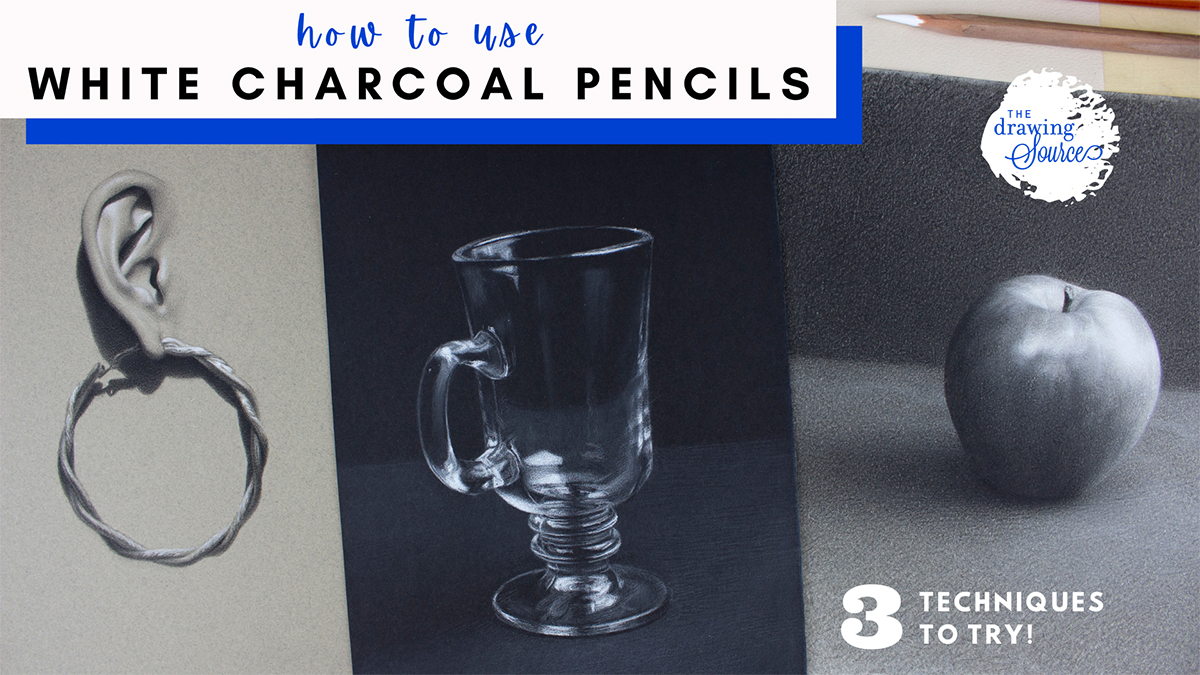
Why use white charcoal pencils?
Whether you're looking to challenge your drawing skills or shake things up in the studio, using these pencils could be just the way to do it! On this page I introduce three of my favorite white charcoal drawing techniques, from least to most advanced.
Drawing Supplies I will be Referring To
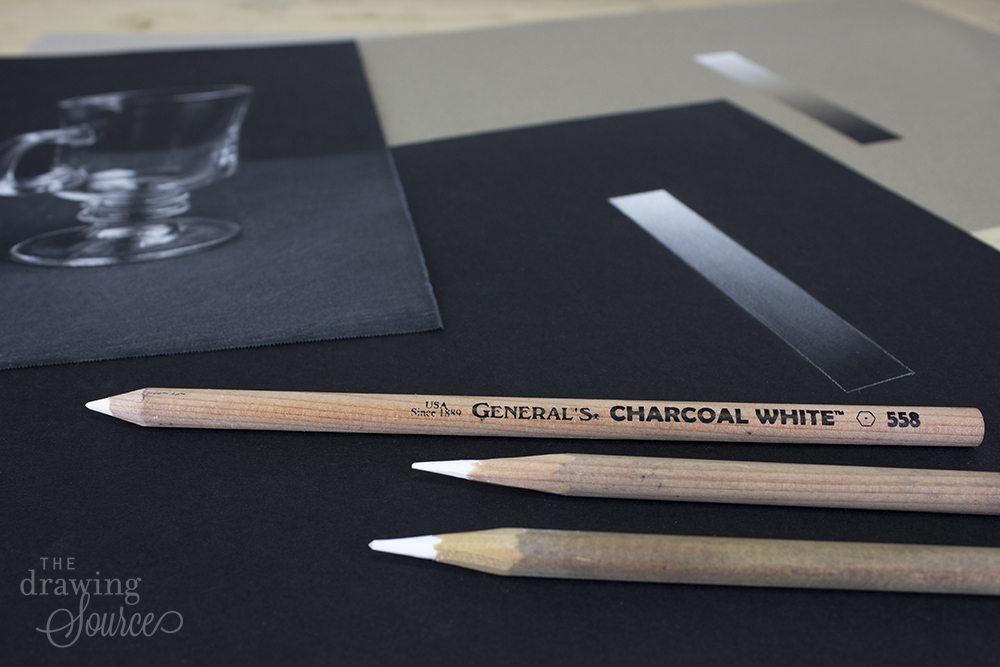 General's Charcoal White 558 Pencil
General's Charcoal White 558 Pencil
Drawing Pencils: The pencils commonly referred to as 'white charcoal pencils' combine beautifully with regular charcoal pencils. I will be using General's Charcoal Pencils and General's Charcoal White Pencil 558.
Drawing Paper: A variety of toned paper can be used for the following techniques. Throughout this page I use Strathmore Artagain Black Paper, toned Artagain Paper by Strathmore, and Strathmore 400 Series Drawing Paper that I toned myself.
This is a brief overview of the materials used throughout this page. However, if you click on the tutorial mentioned in each technique description, you can view a detailed list of drawing supplies used to create that specific drawing.
White Charcoal Pencil Technique #1:
Blend white charcoal with regular charcoal
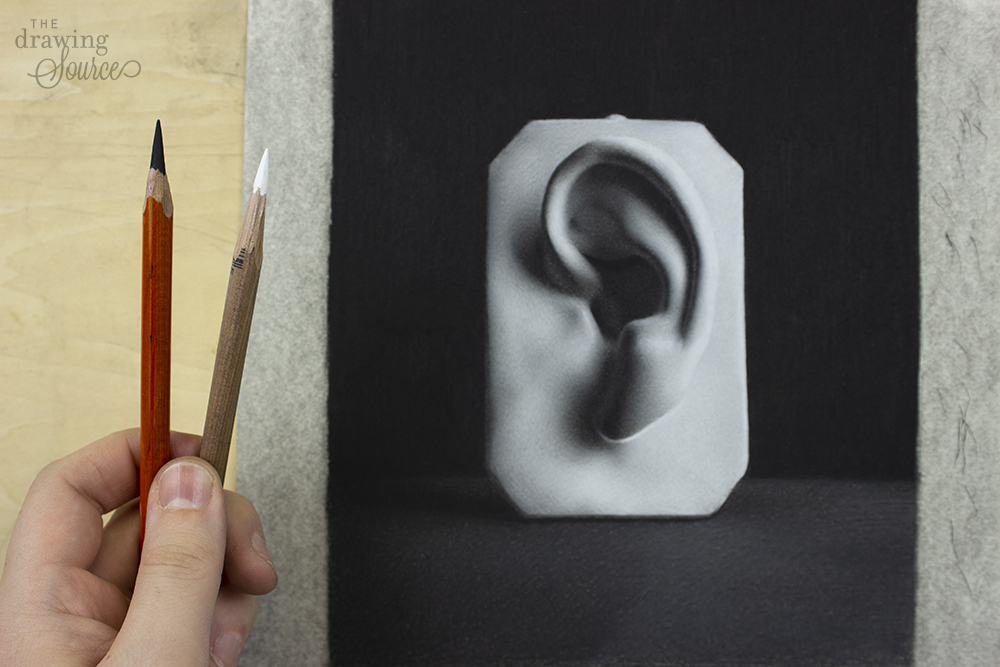
Step by Step Tutorial using this Technique: Ear Cast Drawing Tutorial
Level of Difficulty: Easiest technique of the three.
In this technique, white charcoal pencils and regular charcoal pencils are blended together. Light values are drawn using white charcoal, dark values are drawn using regular charcoal, and middle values are drawn by mixing and layering the two. As you can see in the image below, the toned paper does not show through in the drawn areas.
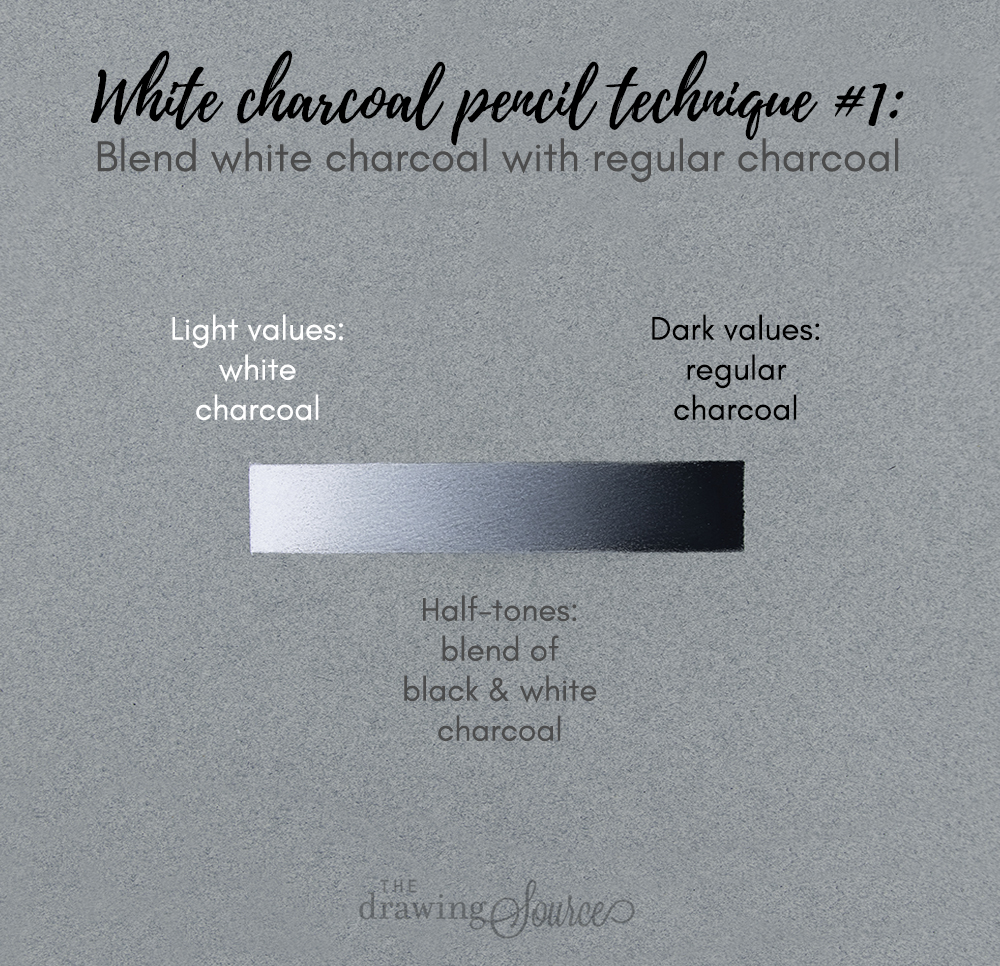
Benefits of Technique #1:
This is such an enjoyable technique, and is one of my personal favorites for the following reasons:
1) There is no erasing!
This technique is entirely additive and does not require any erasing (well, you certainly can if you want to, but it's not necessary). To darken an area of your drawing, you add dark value with a regular charcoal pencil, as you normally would. However, to lighten an area, instead of erasing you can add light value with a white charcoal pencil! Darker, drawn areas can be lightened by layering lighter value overtop, as black and white charcoal blend together beautifully.
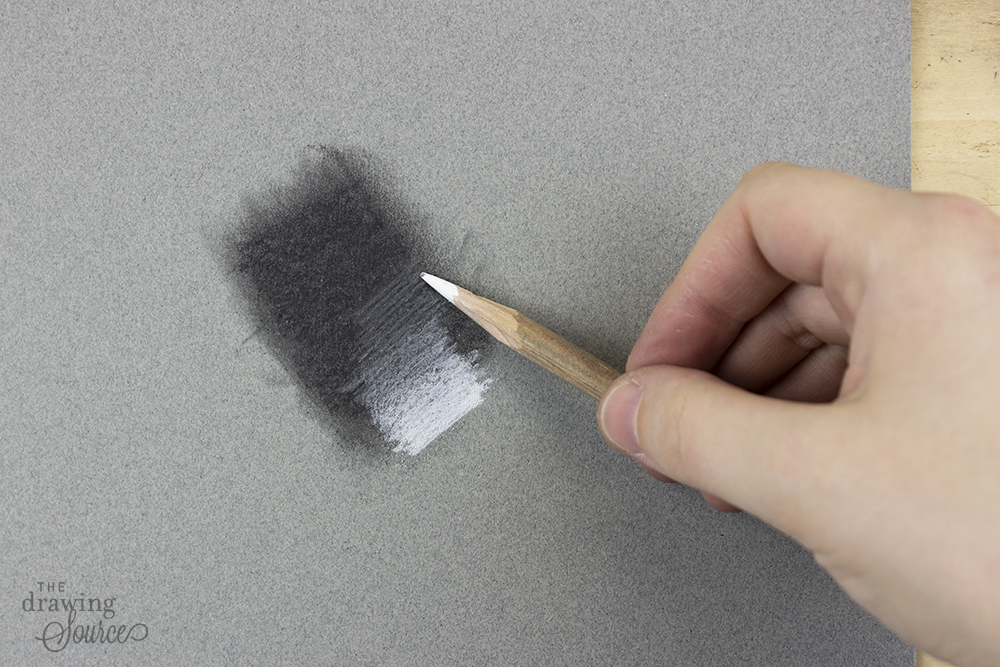 Lightening a dark value by layering white charcoal overtop
Lightening a dark value by layering white charcoal overtop
2) It has unique aesthetic qualities
Blending white charcoal with regular charcoal 'cools its temperature', meaning that it gives the charcoal a bluer hue than it normally has.
The two drawings in the image below were both drawn on Strathmore 400 Series Drawing Paper. However, in the left drawing, I toned the paper lightly and then used white charcoal throughout. The right drawing was drawn only with regular charcoal pencils (no white charcoal).
Do you see the temperature difference? The left drawing is distinctly bluer than the right one.
White charcoal also gives drawings a quality that I can only describe as 'silvery' or 'velvety', though it rarely translates in photos.
 White charcoal was used in the left drawing, giving it a bluer hue than the drawing on the right.
White charcoal was used in the left drawing, giving it a bluer hue than the drawing on the right.
3) Black and white charcoal blend together very nicely with an inexpensive paintbrush
This makes it easier to achieve smooth, even values and gradations.
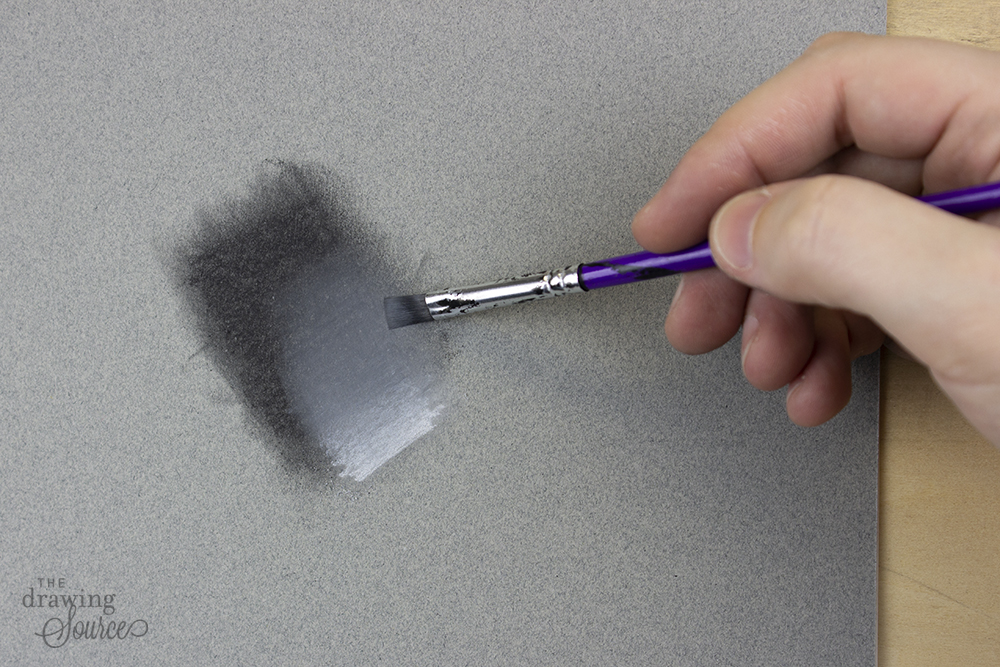 Blending black and white charcoal together with a paintbrush.
Blending black and white charcoal together with a paintbrush.
This technique can be used on homemade toned paper, like the ear drawing pictured above, or on store-bought toned paper, like the gradation above. One is not better than the other - it's completely a matter of personal preference.
I often choose to tone my own paper because it allows me to 'skip a step': as soon as I begin using white charcoal on my homemade toned paper, it immediately starts to combine and blend with the regular charcoal. This simply cuts back on some blending time.
However, that's just my personal preference! Experiment with store-bought toned paper vs homemade toned paper to determine what you prefer.
Challenges of this Technique
- When using white charcoal in this blended way, remember that wherever it is applied, it will cool the temperature of the black charcoal. If you only use it in some areas, you will have cooler and warmer areas of your drawing. You may like this variation and choose to use it intentionally, or this may bother you. You can unify the drawing by using white charcoal throughout the entire drawing (even very lightly in the darkest areas to cool them slightly, giving them the blue hue present in the rest of the drawing).
- If you layer a lot of charcoal repeatedly, there can come a point where your drawing paper will not be able to hold any more pencil dust. You can minimize the chance of this happening by using a good quality drawing paper with a little bit of tooth, or texture, to it: slightly 'toothier' paper can hold more pencil dust. You can also analyze the values in the scene that you're drawing and plan your value structure, so that you have a better idea of what value is needed where, and don't have to modify your values too many times. Learn how to plan your value structure in lesson 5 of my free Mini-Course.
When to Use this Technique
This technique works beautifully with a variety of subject matters. I have used it for quick-sketch figure drawing, for drawing interior spaces, still life drawings - really anything you can think of.
Check out a full step by step tutorial using Technique #1 here!
White Charcoal Pencil Technique #2:
White charcoal on black paper
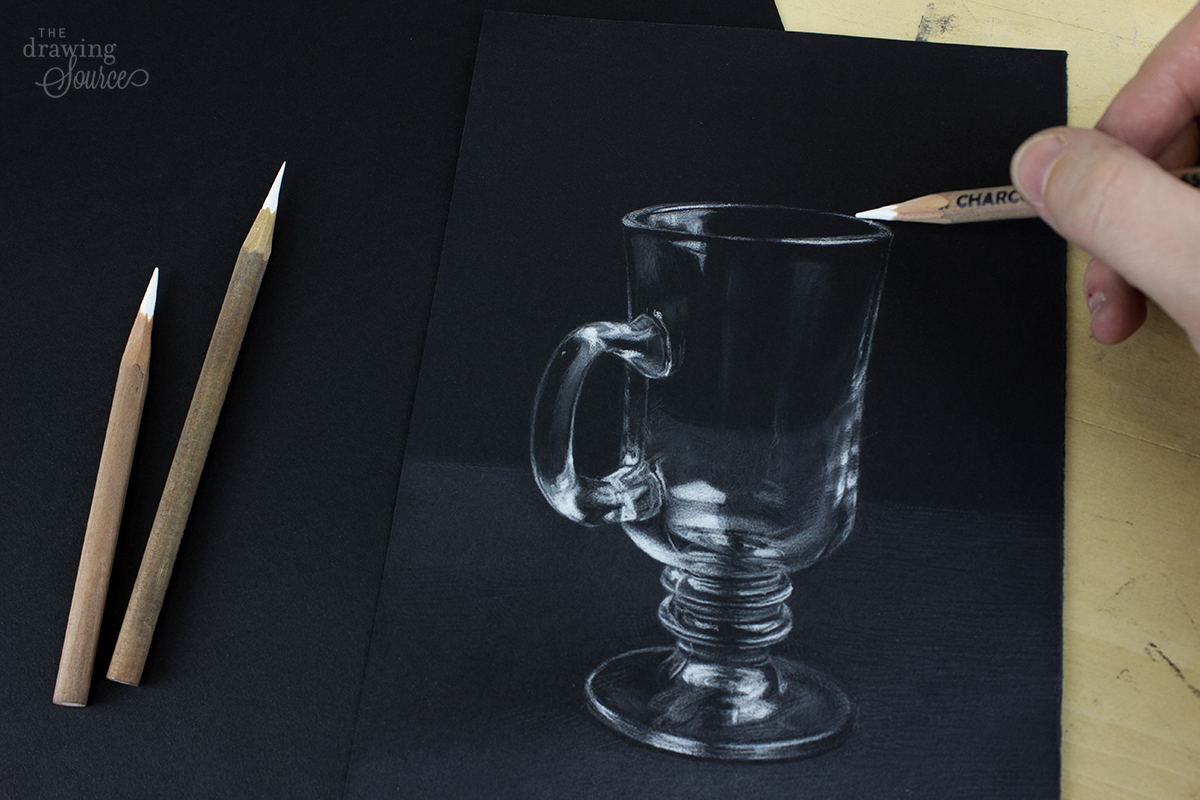
Step by Step Tutorial using this Technique: How to Draw Glass Using White Charcoal on Black Paper
Level of Difficulty: Medium.
Technique #2 involves drawing with only white charcoal on black paper, as opposed to a dark pencil on light paper. Variations in half-tone values are achieved by adjusting the pressure of your marks with the white charcoal pencil. You can use a kneaded eraser to help even out your pencil marks and create a range of middle values.
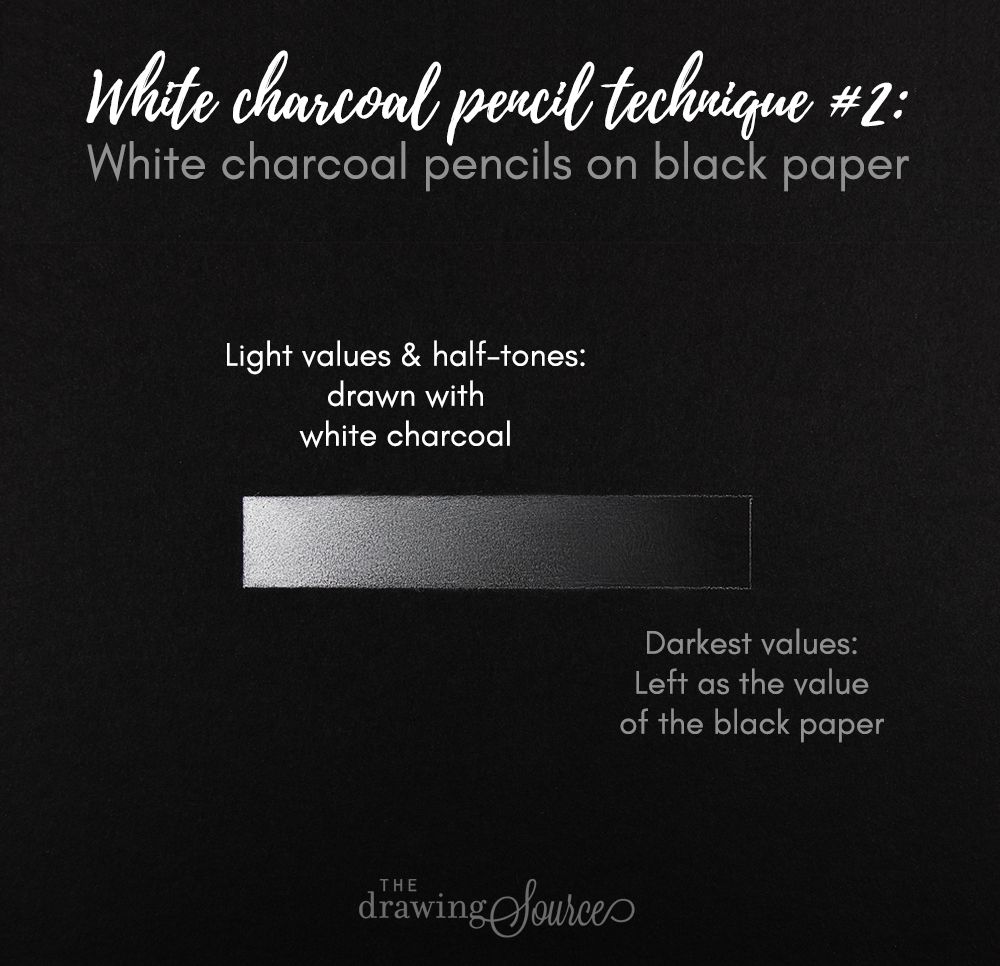
Benefits of Technique #2
How often do you get to use a single (type of) pencil?! All you need for this is a General's White Charcoal Pencil!
A benefit of this technique is that it can be quite quick: because it is most often used on high-contrast subjects (that consist mostly of extremely dark and extremely light values), applying only the light values can often take less time than applying the dark values in a regular drawing.
Finally, these drawings are usually very dramatic and striking!
Challenges of this Technique
This technique may require a considerable shift in your mindset! W e would normally leave the paper blank where lightest values are needed and add value to darken shadows, right? Well, here we will leave the paper blank where shadows are needed and add value to create the light areas. It sounds simple enough, but it may have you scratching your head every once in a while!
It may also take some getting used to that a kneaded eraser is used to darken rather than to lighten values in this scenario.
Finally, since you can't switch pencil grades in order to make it easier for yourself to draw lightly (for example, in a regular drawing you could switch to an HB or even a 2H charcoal pencil to draw the lightest values), it is a benefit if you have a sensitive hand when using this technique. However, if you don't, that's all the more reason to try this method! It will be excellent practice and increase your control of your drawing tools. If gaining control, stability and sensitivity with your drawing pencil is something you are working on, please check out my video on the topic.
Don't let these potential challenges dissuade you from trying this technique! With a little bit of practice you could very well come to love it.
When to Use this Technique
It makes the most sense to use this technique when your subject matter consists predominantly of dark values.
Check out a full, step by step tutorial using Technique #2 here!
White Charcoal Pencil Technique #3:
Leave half-tones as the value of the toned paper
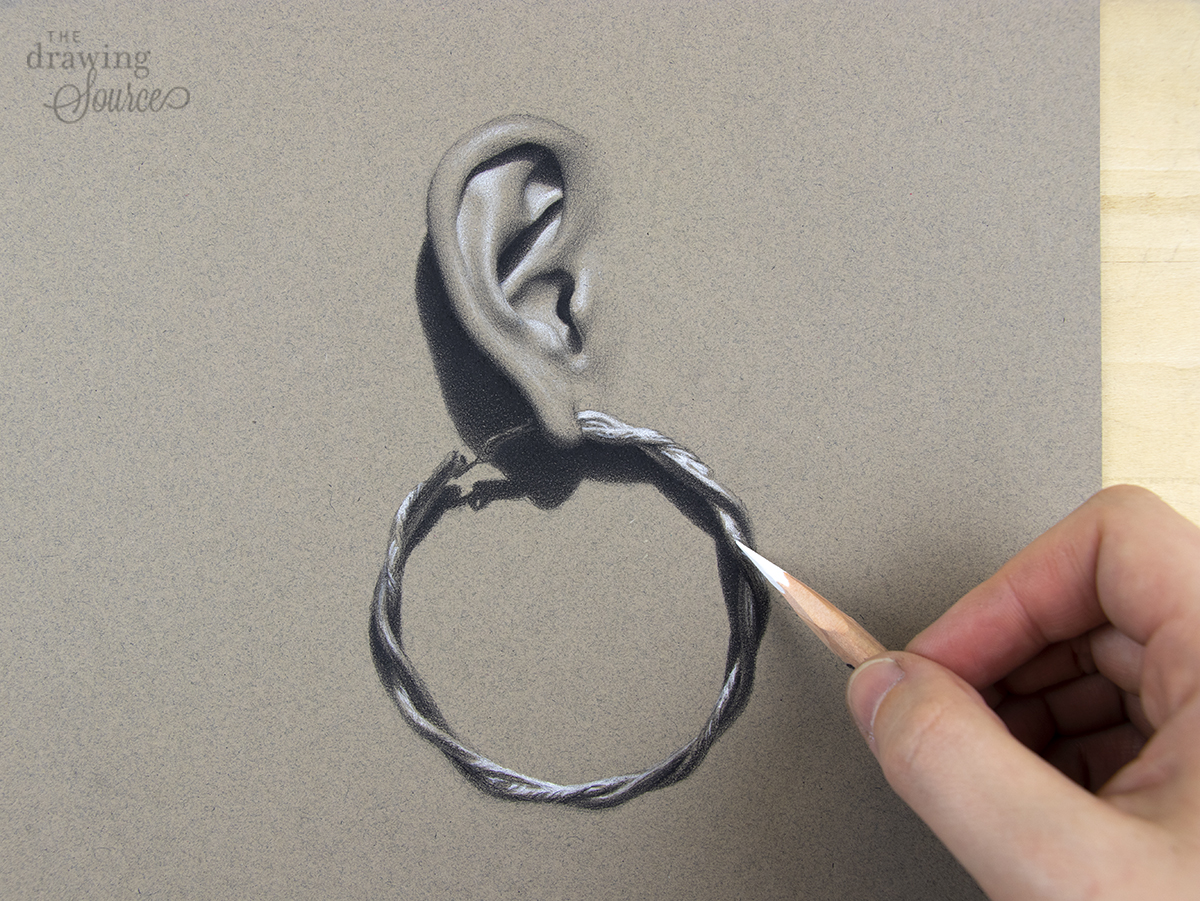
Step by Step Tutorial using this Technique: How to Draw an Ear on Toned Paper
Level of Difficulty: Most advanced of the three techniques.
In this technique, light values are drawn using white charcoal pencils, dark values are drawn using regular charcoal pencils, and half-tone values are left as the value of the paper. As you can see in the images above and below, the toned paper shows through only where there are middle values.
As opposed to Technique 1 where the charcoal is applied opaquely, here both white charcoal and black charcoal are applied more 'transparently', gradually gradating into the tone of the paper to create a range of middle values.

Benefits of Technique #3
This technique gives drawings a distinct look, almost as though they are growing out of the paper. It can also be a great way to add some color to your drawing, as toned paper comes in various shades and hues.
Finally, this technique will challenge you. Wait - the benefit is that it's a challenge? Sure! At some point during your drawing education you'll get comfortable with the technique you've been working with and desire to stretch your drawing skills. This could be just the method for you to do that!
Challenges of this Technique
This technique requires more planning of the value structure of your image: you need to be very mindful of where the light values, middle values and dark values are on your subject, so as not to cover up the middle values with pencil marks, and to keep the white and black charcoal separate. Learn how to plan the value structure of your drawing effectively in Lesson 5 of my free Mini-Course!
When to Use this Technique
This technique works especially well when your subject matter consists predominantly of middle values. However, it can be used effectively in other scenarios as well. For example, notice that the earring in the drawing above is high in contrast: it is made up of mostly very light and very dark values, so the paper shows through very minimally.
Check out a full, step by step tutorial using Technique #3 here!
Three White Charcoal Pencil Drawing Techniques:
A Summary
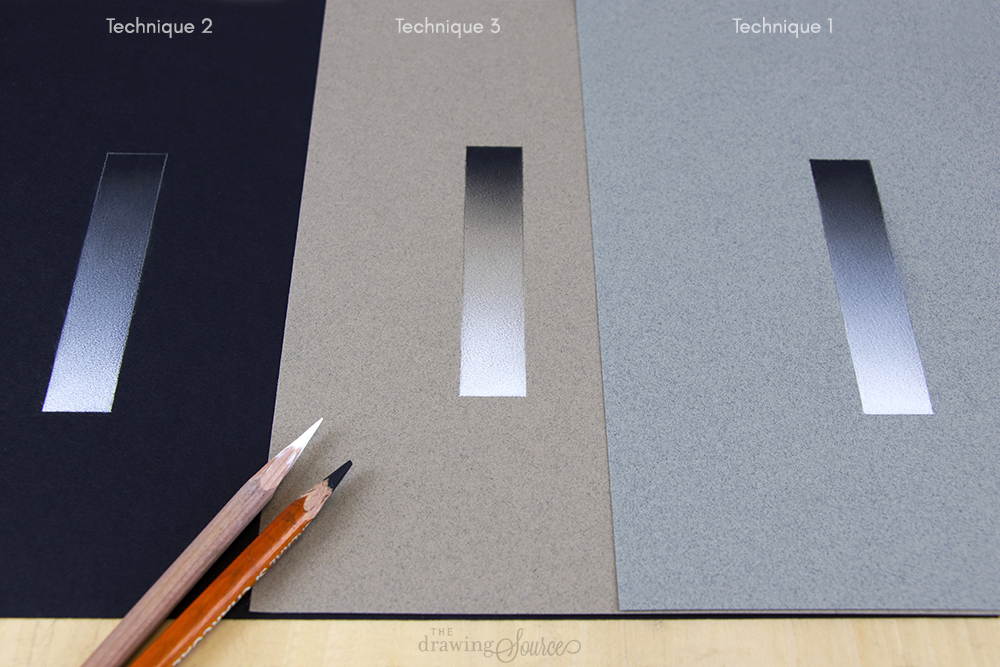
Technique #1: White charcoal and regular charcoal are blended together
Technique #2: White charcoal is used on black paper (with no addition of regular charcoal)
Technique #3: Both white charcoal pencils and regular charcoal pencils are used but remain separate, allowing the toned paper to show through as the middle value of the drawing
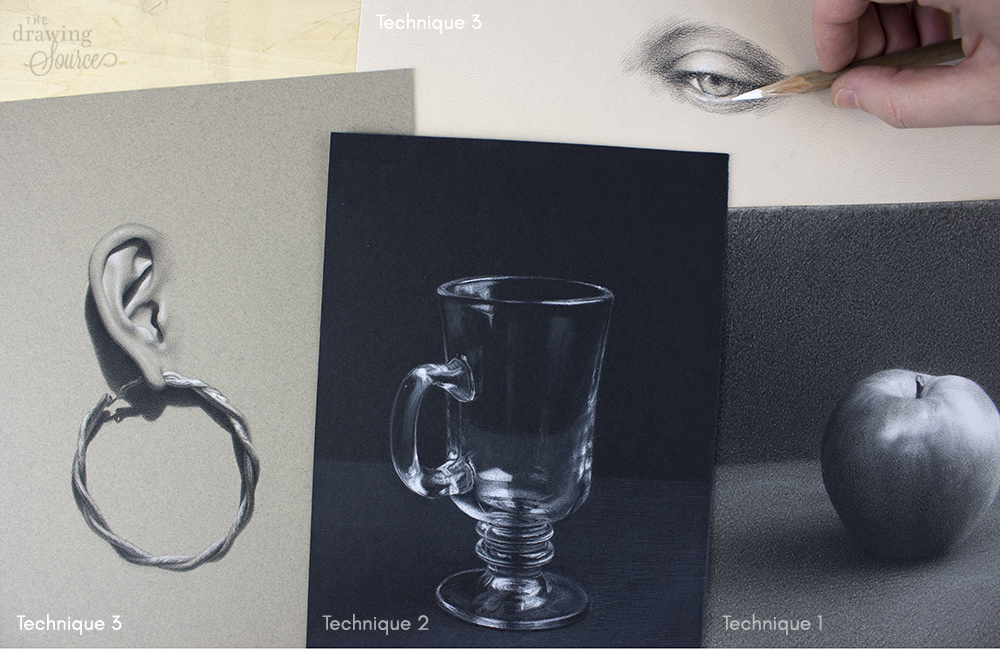
Is this an exhaustive list of techniques to try with white charcoal pencils? Definitely not!
Could you combine a few of the above techniques in a single drawing? Absolutely! Once you've got the hang of these techniques separately, why not experiment with blending white and black charcoal opaquely in some areas, and transparently in others.
I hope you enjoy experimenting with white charcoal pencils!
Happy drawing,
![]()
![]()
Enjoyed this page? Please share it!
Share buttons and pinnable image below:
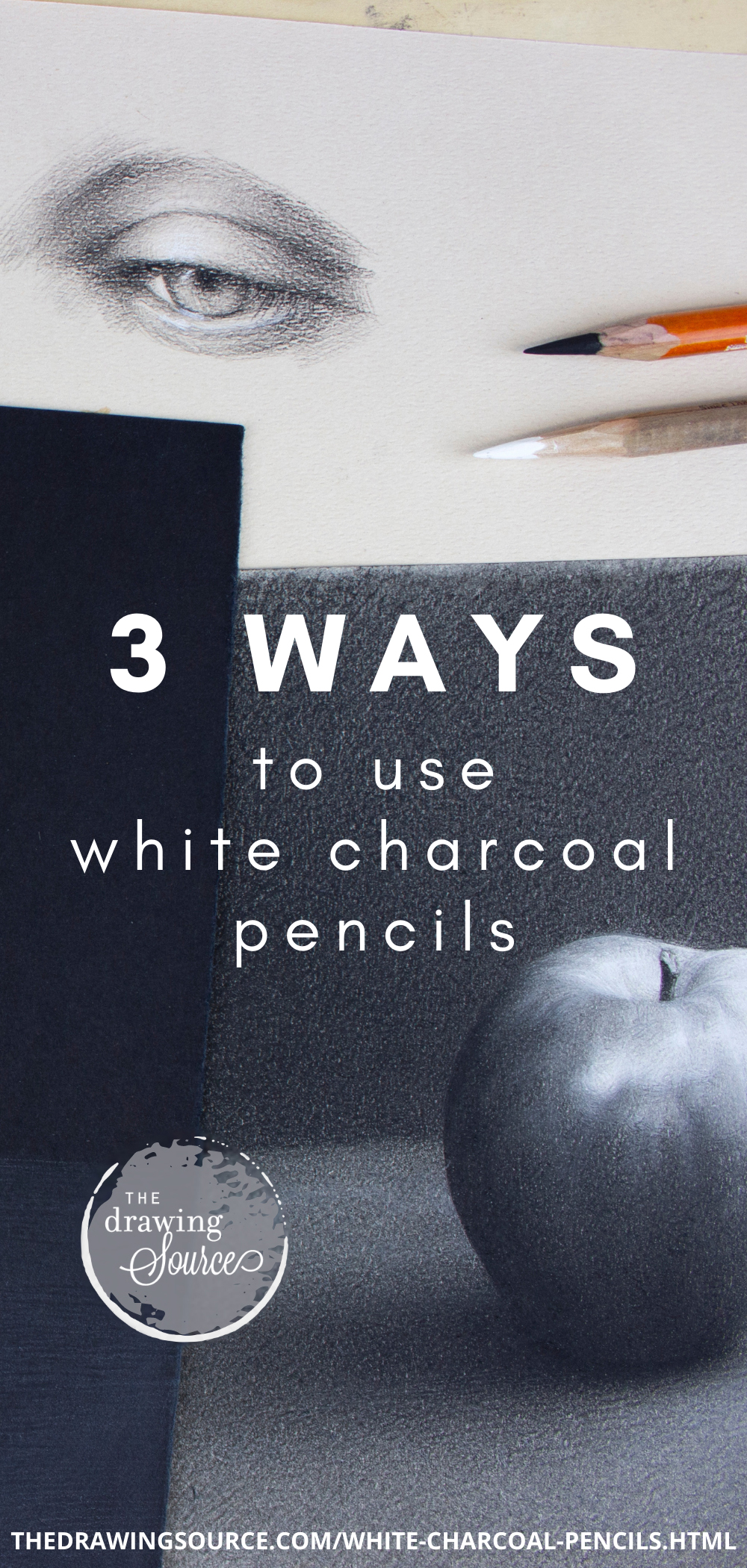
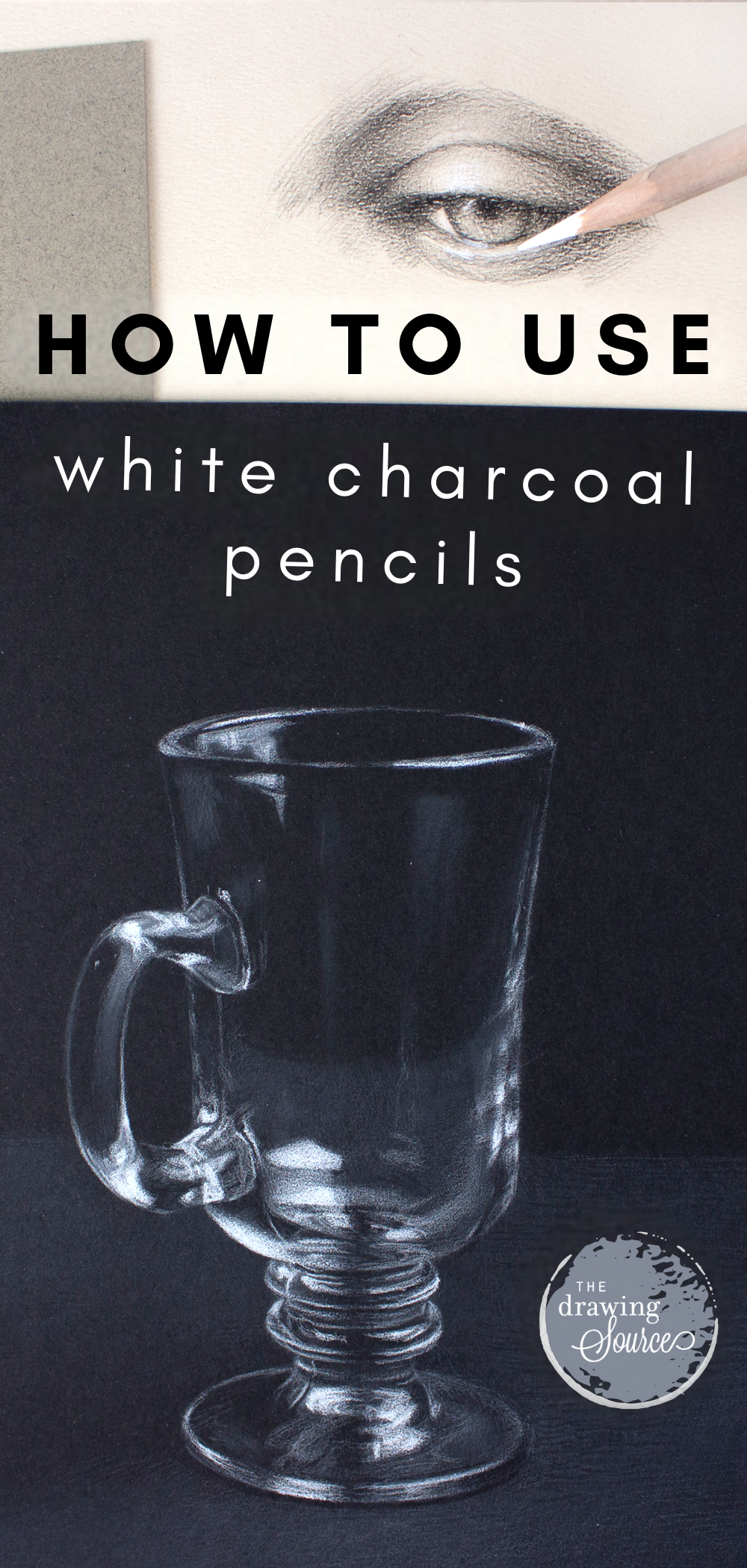
![]()
If you enjoyed this page on drawing with white charcoal pencils, you may also enjoy ...
How to Draw Glass using White Charcoal on Black Paper
How to Make Toned Paper
How to Hold and Control a Drawing Pencil (Video)
3 Ways to Use a Kneaded Eraser (Video)
Return to Drawing Supplies from 3 Ways to Use White Charcoal Pencils
Return to Drawing Tutorials from 3 Ways to Use White Charcoal Pencils
How to Draw Landscapes Charcol Pencile
Source: https://www.thedrawingsource.com/white-charcoal-pencils.html
0 Response to "How to Draw Landscapes Charcol Pencile"
Postar um comentário